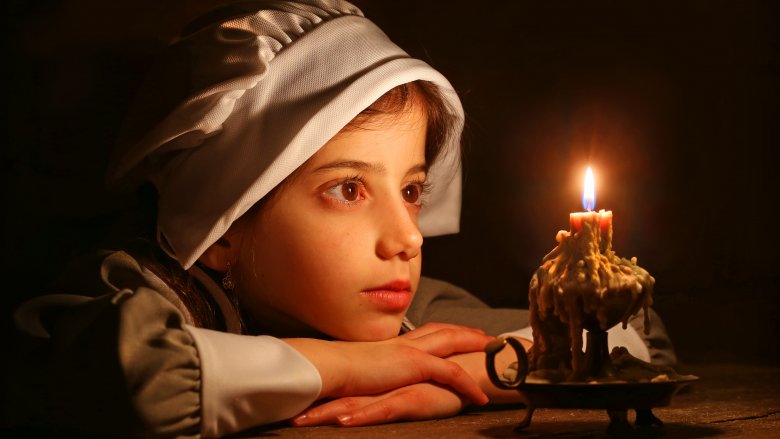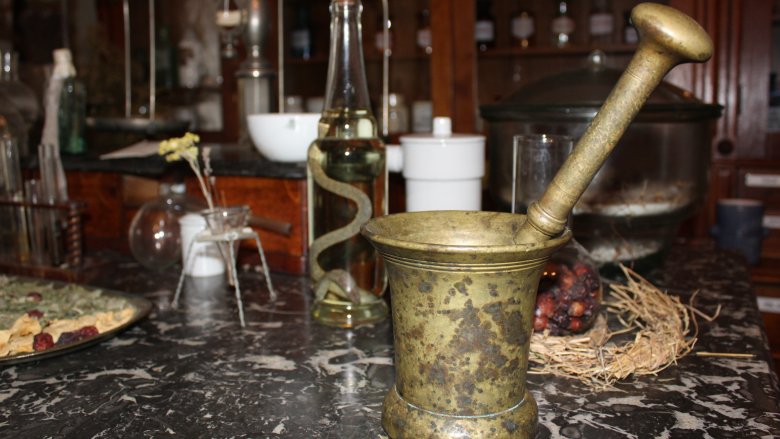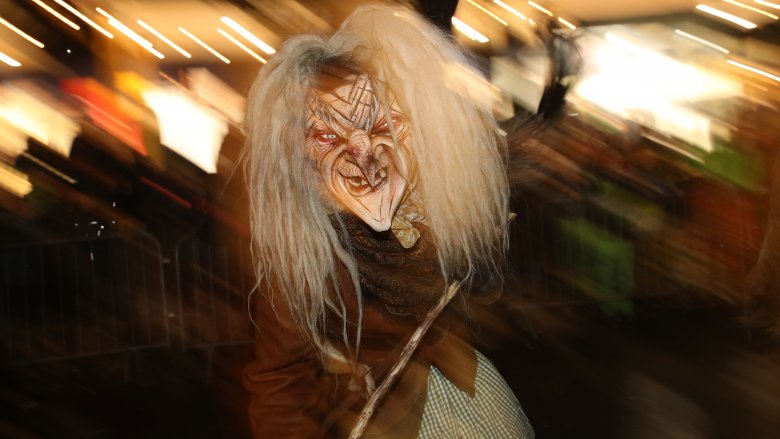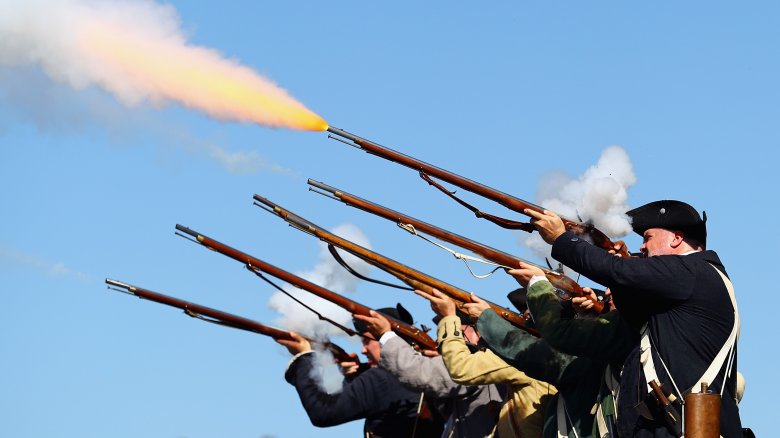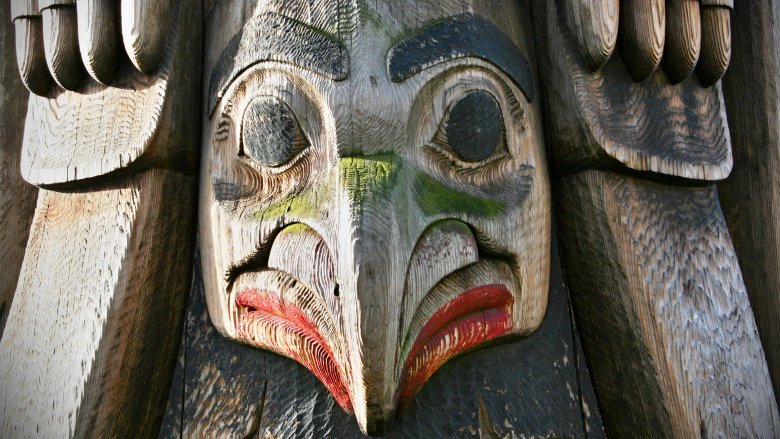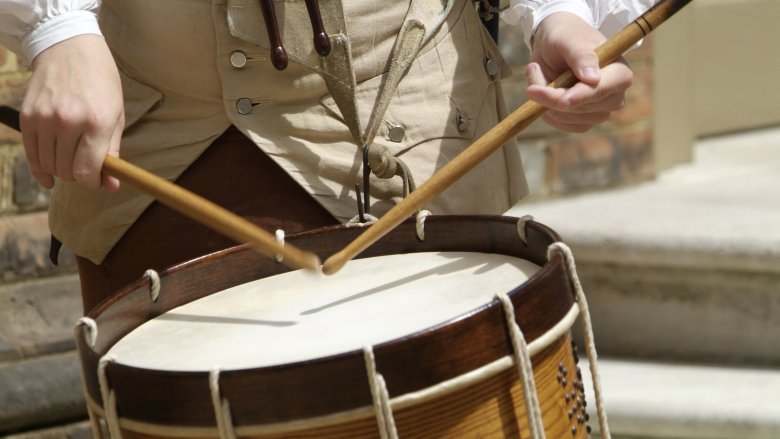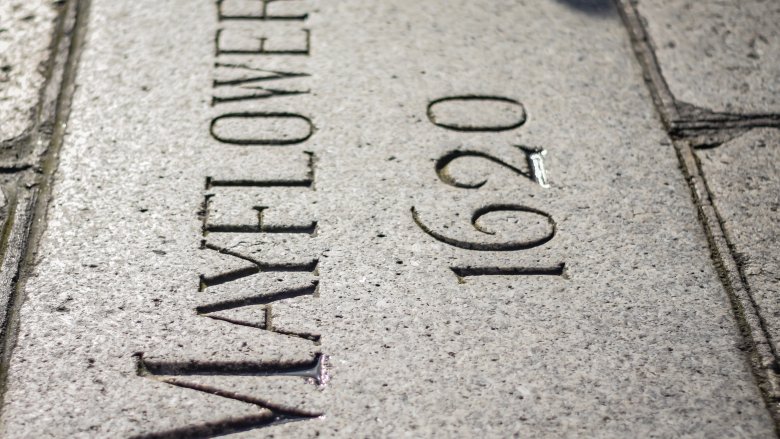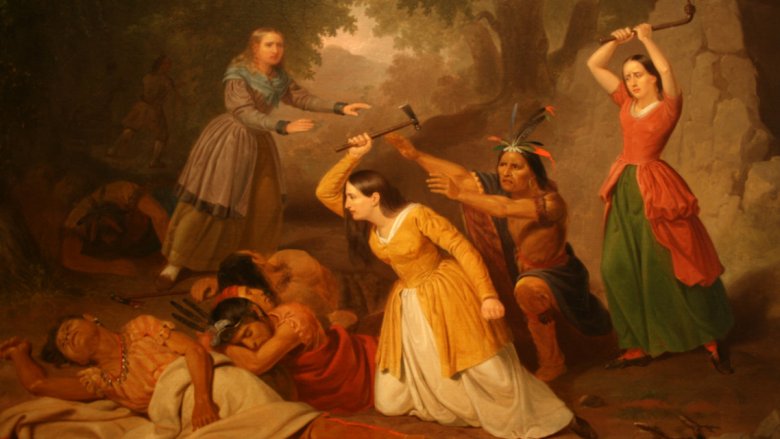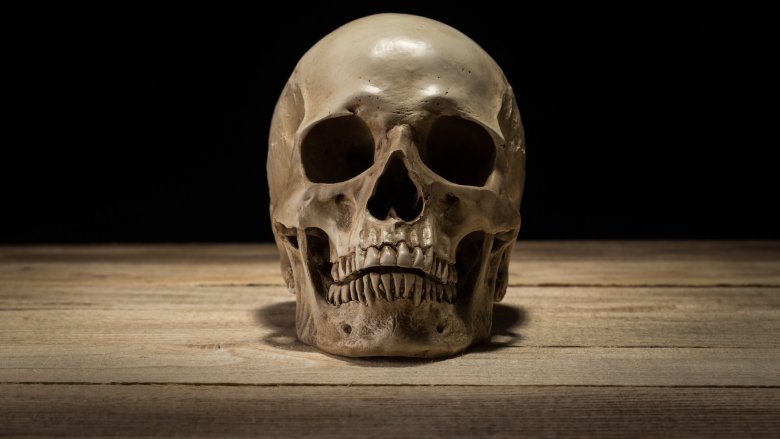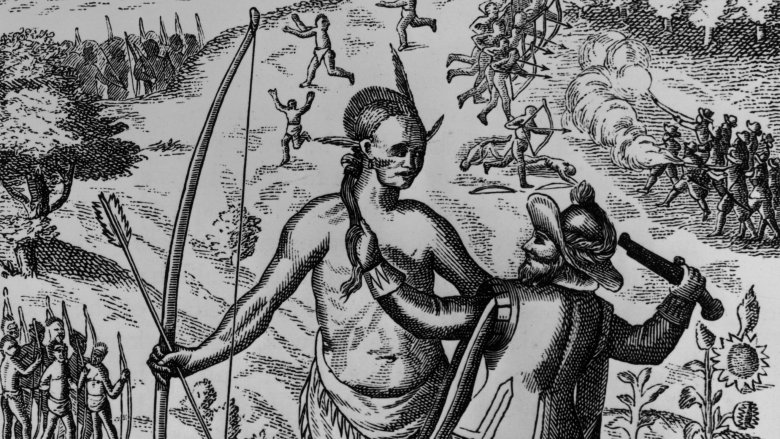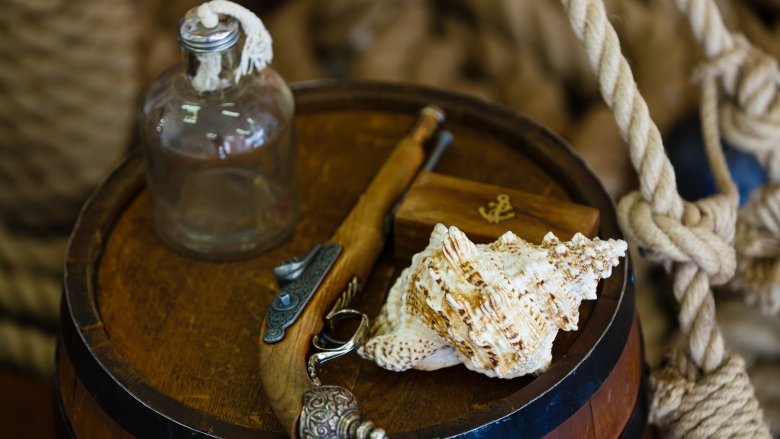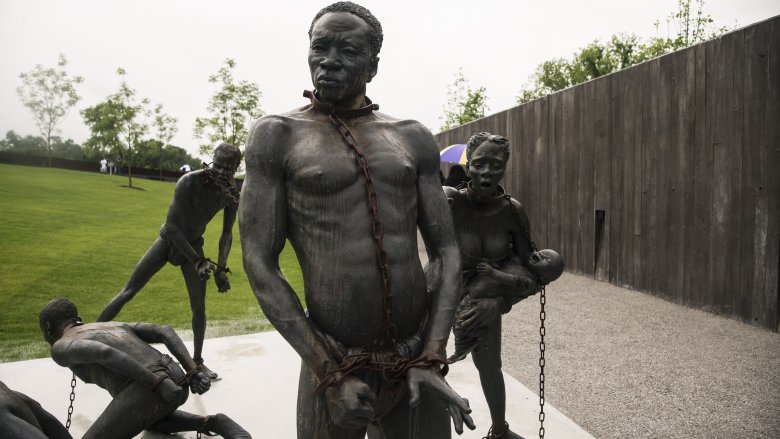Messed Up Things That Happened During Colonial Times
It's possible you weren't taught much about colonial America in school, and that's a shame. We get it, schools have a lot to cover. But taking the time to wade into what was going on in North America before the USA is important. Party because it's a fascinating look at where our roots are, and partly because there was some seriously messed up stuff going on.
Jamestown cannibalism
The winter of 1609 was bad. The Smithsonian says it was called the Starving Time. So really, really bad. We know how bad they were because of survivor George Percy. He wrote that when there were no more horses, rats, cats, and dogs, the living started looking at the dead with less sorrow and more hunger. Percy wrote about people who dug up graves they'd just filled in, eating the flesh of the dead and even drinking blood from people who still lived but were too weak to protest.
Yikes. There were others who wrote about the Jamestown colonists and the extreme steps they took to survive, but it wasn't until 2012 we found physical proof to support the writings. Archaeologists called her Jane and reconstructed her fate after finding her partial skull buried alongside the bones of butchered horses and dogs. Forensic anthropologist Douglas Owsley — who has worked cases like Jeffrey Dahmer's — says she was around 14 years old and probably died of natural causes before starving colonists ate her brain (which decomposes quickly), tongue, face meat, and leg muscles. Cut marks on her skull suggest she was initially butchered by someone who hesitated in the act, while her legs bore more skilled, almost professional cuts. You know what they say about desperate times.
The basic principles of colonial medicine
Historian Martha K. Robinson says there were no facilities for training new doctors in the colonies until 1765, when the Medical Department of the College of Philadelphia finally did open its lecture halls. Then, they were training doctors based on two current European theories. William Cullen surmised illness usually came from some kind of contagion, and kudos to him for being on the right track. Not everyone agreed, though, and Herman Boerhaave's school of thinking basically said there were two forces at work in the human body: solids and fluids. Keep them in balance and the person would be healthy.
That's a bad idea, but strangely, treatment options were pretty standard no matter what your doctor was taught. They still believed that treatment with the most visible effect on a patient was the most effective. What's that mean? Whatever knocked people out the fastest or gave people the most violent vomit or the most explosive diarrhea was clearly the most effective because they were getting rid of the corruption assailing them. No one likes going to the doctor, but at least today you can be pretty sure they're not just going to give you something to make you sweat, run, and vomit as violently as possible.
The witch hunts of Hartford
Before Salem, there was Hartford. In 1642, Connecticut made witchcraft an offense that could get someone the death penalty, and Connecticut History says it only took a few years before that's exactly what happened. Alse Young was hanged for witchcraft in 1647, at the same time Mary Johnson was having her own confession whipped out of her. She confessed to witchcraft and was hanged later, her life only prolonged by her pregnancy.
We're not actually sure how many people were accused of witchcraft because records are iffy, but we're pretty sure 11 — including two men — were hanged. Others fled or were banished, according to Time, and it had to be terrifying. It only took a single witness to put someone on trial and get a guilty verdict. Could just be one person who doesn't like you! One woman was sentenced to death after being accused of practicing witchcraft that made one of her neighbors shoot another man, which seems at least a little shady. It wasn't until 1662 that authorities slowed down and rethought what they were accepting as evidence in these trials. That included determining whether or not witnesses had something to gain from their accusations. It didn't fix everything, but it was a step in the right direction.
The Pequot massacre
Never heard of the Pequot massacre? Let's change that. In the 1630s, Puritan settlers were fighting the local Pequot people over a patch of land in what's now southern Connecticut. The war lasted three years, and until May 26, 1637, it looked like the Puritans were going to be driven off the land they were trying to take. But that was the day they swarmed Mystic Fort and killed around 500 men, women, and children.
University of Connecticut anthropologist Kevin McBride (via Indian Country Today) says there's no question this particular episode in history can be called a massacre, adding it was the first of three similar incidents that would go on to shape relations between Puritan settlers and native peoples. Despite having 70 well-armed English soldiers and 250 others on their side, the Puritans almost lost. Until, that is, they trapped the Pequot inside their fort. According to Battlefields of the Pequot War, English attackers initially tried to enter the fort, but lost about half their number. So they played dirty. They set the whole thing on fire and killed anyone trying to flee the flames. After the attack, Pequot in other villages throughout their ancestral territory fled to other tribes for safety but were pursued by the relentless march of the English. Two more villages were completely destroyed, and it helped set the tone for decades of future conflict.
The Phips Proclamation
There's still a strange tendency for people to think there's nothing uncomfortable or racist about calling a sports team the "Redskins," so let's take a look at where the term actually comes from and why it's not cool.
In 1755, the Massachusetts government issued something called the Phips Proclamation. It was essentially a massive bounty letter, and promised enterprising, bloodthirsty individuals they would be paid well for any Penobscot brought to them, either in chains or in pieces. The highest bounties were paid for men taken to Boston — alive — but if that was too much work, they'd also pay for scalps. And that's scalps of any person, any age. If you were to, say, scalp a pair of toddlers, you'd walk away with a cool 40 pounds.
No one really needs to spell out why that's messed up, right? Those scalps were called "redskins," which puts cheering for your Redskins at a Friday night game under the lights in a whole new light. Baxter Holmes in Esquire about what the term still means today: "It represents a trophy of war — the bloodied scalp of a murdered Native American, slaughtered for money, the amount dependent on whether it was a man, woman, or child." It goes back to colonial America and Spencer Phips, and you can call him what you like.
An 82-year family feud creates the Mason-Dixon line
You've heard of the Mason-Dixon line, and you probably know it as the border between the north and the south. You might also think it's pretty unnecessary because we already have all kinds of other borders we can use. Why this one? Because of an 82-year family feud.
According to the Maryland Historical Society, it started when England's king gave William Penn II the go-ahead to just lay claim to everything between Maryland and New York. That 1681 order is pretty vague, and you can see the problem already. Things got ugly, surveys weren't completed, and mediations and conferences didn't help. Finally, Charles Mason and Jeremiah Dixon were summoned all the way from the Royal Observatory in England to put the whole thing to rest.
In the meantime, the Smithsonian says there was a whole lot of hate going around. There was never any outright war, but there was plenty of border skirmishing, arson, and (occasionally) murder. When the two territories signed a peace treaty in 1738, they agreed there wouldn't be any more "Tumults Riots or other Outragious Disorders to be committed," but it was still another 12 years before the border was legalized, and a further 17 years until the Pennsylvania Penns and the Maryland Calverts agreed on the Mason-Dixon line, all of which makes your angry neighbors look like amateurs.
The near-sinking of the Mayflower and the first settler murderer
Some folks have an idealized vision of those people who first came to the New World on the Mayflower, and we tend to think of them as the devout sort who spent the journey alternately praying and being kind to their neighbors. That definitely wasn't the case for all of them. Let's talk about John Billington and his family.
First off, his sons were kind of jerks. According to Mental Floss, the Billingtons were fleeing to the New World to escape some serious debts he'd run up in England, and thanks to the Billington kids, the ship almost didn't make it. At one point, one of the boys decided it was a brilliant idea to play with dad's gun and fire it below decks in a cabin full of people and barrels of gunpowder.
Once they landed, it became clear where they'd learned their manners from. John Billington not only refused the mandatory bit of military service but started spouting anti-establishment propaganda while plotting to overthrow the new colony's leaders. For whatever reason, he was allowed to continue his hate-talk, and it wasn't until 1630 he got into an argument with a new settler and shot him. As you do. The man, John Newcomen, died from infection and Billington had the dubious honor of being hanged as the first settler murderer.
The revenge of Hannah Duston
We'll tell the whole story here and let you make your own decisions about how heroic Hannah Duston was because 99% Invisible isn't sure. Duston lived in Haverhill, Massachusetts in 1697, and she had just given birth to a daughter when her little settlement was attacked by a group of Abenaki. Duston, her baby, and maid Mary Neff were taken and marched north. Historic Ipswich adds a horrifying but important detail: When the baby slowed them down, she was smashed against a tree and killed.
Everyone can agree no mother should ever have to go through something like this. It's no wonder Duston had some serious rage, and when the raiding party and their captives stopped for an overnight rest in New Hampshire, she got her revenge. Duston, Neff, and a boy named Samuel killed the entire group as they slept. Knowing no one would believe them without proof, they scalped them, too.
That included six children. Duston made it back home, and went on to tell her tale to the minister Cotton Mather. He ensured it was recorded for history, and it's been memorialized in weird ways. There's a nursing home named after her, bobbleheads in her likeness, and there's a statue to her in Boscawen, New Hampshire. Yes, her statue is holding scalps. Discuss.
The dead teenager's unmarked grave
When archaeologists working in Anne Arundel County, Maryland, uncovered the skeleton of a teenage boy, they uncovered a murder case, too. The details they have discovered — thanks in large part to forensic anthropologist Douglas Owsley — paint a grim picture of colonial life.
The boy was found buried with fireplace ash, animal bones, and a milk pan that was probably used to dig his grave. Only about 15 years old, his spine already showed serious damage from a life of hard labor, and his teeth were just as bad. His wrist was broken, likely warding off blows that ultimately killed him. Add in his secret burial, and the Smithsonian says he was likely one of the countless indentured servants who went to the New World hoping to find a better life but found the opposite.
He was killed and buried between 1665 and 1675, and that was the same time laws were being passed forbidding private burials of servants just like him. The deaths of servants and the secret burials were happening so often there were finally laws being put in place to prevent exactly this kind of violence, abuse, and murder, too late for this teen.
Populating the colonies with unwilling people
Not everyone who ended up in the New World went there looking for a better life, and not everyone went of their own accord. We've all heard that Britain used Australia as a massive penal colony, and guess what? They did the same thing in colonial America, and according to Gizmodo, around 52,000 convicts were shipped across the Atlantic.
That includes people convicted of a whole host of crimes, from felonies to women who were out in public after 10 p.m. (Seriously.) There were so many that in 1670, Virginia tried to pass a law forbidding entry to any British convict, but the king was having none of that upstart nonsense and overturned the law. Pennsylvania tried, too, with similar results.
Now, let's talk even more messed up. Britain also saw the colonies as the perfect way to get rid of all the orphans and urchins who were clogging city streets. Ship them overseas, too! The National Museums Liverpool says the first group was sent in 1619, when 100 little tykes were rounded up off the streets and sent to live in Jamestown. Another hundred were sent to Virginia in 1622, when a settlement was in need of more people to make up for numbers lost in a major massacre. Can things always go from bad to worse? Easily.
Colonial germ warfare
People have a long history of being generally horrible to each other, but every so often an obscure piece of history resurfaces that simply serves as a reminder of the depths humans will sink to. One of those low points happened in 1763, when Native Americans laid siege to the British settlement around Fort Pitt. The British retreated into the fort, and things were looking dire.
Historians from Colonial Williamsburg say it got dark real fast (morally, not optically), when two Native American representatives approached the fort to appeal for an end to the fight. The Brits refused, but Sir Jeffery Amherst did give the representatives a parting gift, hoping to thin the ranks. One local trader described the incident in his journal, writing, "We gave them two Blankets and an Handkerchief out of the Small Pox Hospital. I hope it will have the desired effect."
This was probably not the only time colonists passed along a gift of blankets infected with smallpox, and it did some serious damage. Historians have tentatively linked an outbreak of smallpox in the Ohio Valley with Amherst's "gift," and it's impossible to tell just how many people died. What happened to Amherst? His name was immortalized in the town of Amherst, Massachusetts (via UMass), even though locals wanted to name the town "Norwottuck," after the area's original inhabitants.
Poisoned peace talks
Everyone knows the story of Pocahontas. She married John Rolfe in 1614, and the marriage brought peace ... short-lived peace. Most stories stop there, but the National Park Service recounts what happened after her father's death in 1618. They got a new chief — Opechancanough — and peace was shattered in 1622 when he organized an attack on the Jamestown area that left around a quarter of the colonists dead.
Reinforcements were called, raids continued, and Opechancanough eventually decided it was time to start the peace talks. He met with Jamestown representatives Dr. John Potts and Captain William Tucker, and they gave the Native Americans an offering of wine.
Nice enough gesture, right? Not really. They had poisoned the wine, and it ended up killing around 200 people. The Jamestown colonists took the opportunity to attack and killed about 50 more, and there's just no turning back from something like that. The following conflict lasted for a decade, which makes losers out of everyone.
The shocking number of 'melancholy accidents'
It's tough to think of America's founding fathers and their immediate ancestors as anything but the responsible sort of people who had their acts together enough to be able to deal with any kind of hardship. But historian Peter Manseau (via the Smithsonian) found something strange when he started digging though colonial news reports: They weren't that responsible after all.
Manseau was working on something completely different when he noticed there were a ton of newspaper reports detailing what colonists called "melancholy accidents." Today, we call them "gun deaths."
There weren't just a few, either — there were hundreds and hundreds of them, too many to include in a single book about America's history of colonial gun deaths. Manseau says the era is filled with stories of people killed by misfiring rifles or by guns that went off accidentally. Other people just happened to be in the wrong place at the wrong time and caught bullets that had been meant for no one. Of those hundreds, he says a few in particular stuck with him: The story of a woman who was ironing handkerchiefs when she was accidentally shot by her 11-year-old nephew. She finished the ironing, then called for help. In another report, a father accidentally killed his child and died of grief a few weeks later. There was a brother who accidentally shot and killed his sister, then tried to kill himself ... they go on and on. Yes, you have a constitutional right to a gun, but be careful with it!
The nation's first slave
While everything about slavery is horrible from start to finish, breaking this terrible chapter of American history down into digestible pieces is just one way to remember how bad it truly was. While slavery has been going on throughout recorded history, the Smithsonian says we actually know who the first slave in America was: John Casor.
Originally, most of the work in the colonies was done by indentured servants. That meant people would pledge to work for others for a finite time, and at the end of that time, they were free. Why would anyone agree to this? There were often incentives like free passage to the New World, ownership of land, or some other bonus to be awarded upon fulfilling the contract.
Until Casor, that is. Casor was the indentured servant of Anthony Johnson, who was a one-time indentured servant himself and one of 20 black people living in the Virginia colony at the time. When they disagreed over whether Casor's contract had been fulfilled (it simply bound him to "seaven or Eight years" of service, which is apparently so vague that Casor's claimed 14 years of service weren't sufficient), they went to court over the matter. The ruling (via Berkeley) was precedent-setting: Since Casor was African, the judge decided he wasn't bound or protected by English law and was therefore Johnson's property. It doesn't get much more messed up than that.
